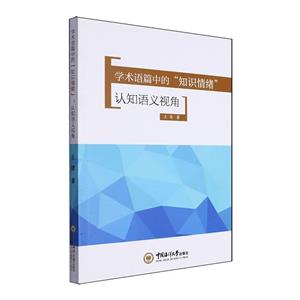-
>
考研英語背單詞20個詞根詞綴
-
>
西班牙語詞根寶典
-
>
美國K-12原版語文課本--初中·下(全12冊)
-
>
流浪地球劉慈欣
-
>
西南聯(lián)大英文課 輕讀禮盒版
-
>
英語大書蟲世界經(jīng)典名譯典藏書系:中國人的精神 (英漢對照)(精選權(quán)威版本)
-
>
許淵沖譯唐詩三百首:漢文·英語
學(xué)術(shù)語篇中的“知識情緒”:認知語義視角:a cognitive semantic perspective 版權(quán)信息
- ISBN:9787567036796
- 條形碼:9787567036796 ; 978-7-5670-3679-6
- 裝幀:一般膠版紙
- 冊數(shù):暫無
- 重量:暫無
- 所屬分類:>>
學(xué)術(shù)語篇中的“知識情緒”:認知語義視角:a cognitive semantic perspective 內(nèi)容簡介
本研究基于認知語義視角,對英語學(xué)術(shù)語篇中認知情緒標記語進行多視角研究,除構(gòu)擬其語義分析框架,揭示不同情感認知語義表征的相似性和獨有性外,還探究了不同學(xué)科、不同性別學(xué)者、跨區(qū)域話語社團和不同時期與學(xué)術(shù)話語情感介入和情感評價的關(guān)系,窺探情感、語言、認知、社會文化與學(xué)科知識建構(gòu)之間的聯(lián)系。研究發(fā)現(xiàn),雖然不同學(xué)科、不同性別和來自不同區(qū)域話語社團的學(xué)者總體上使用知識情緒標記建構(gòu)學(xué)科知識時并未呈現(xiàn)出顯著差異,但學(xué)者在學(xué)術(shù)發(fā)表中使用知識情緒標記進行學(xué)術(shù)交流的愿望日趨增加。
學(xué)術(shù)語篇中的“知識情緒”:認知語義視角:a cognitive semantic perspective 目錄
學(xué)術(shù)語篇中的“知識情緒”:認知語義視角:a cognitive semantic perspective 作者簡介
王倩 香港理工大學(xué)博士,西北工業(yè)大學(xué)外國語學(xué)院副教授,碩士研究生導(dǎo)師。主講本科生/研究生課程6門,主持/參與多項省部級科研/教育教學(xué)改革研究項目及國家級/省級/校級一流課程建設(shè)等。
- >
我與地壇
- >
我從未如此眷戀人間
- >
名家?guī)阕x魯迅:故事新編
- >
詩經(jīng)-先民的歌唱
- >
山海經(jīng)
- >
名家?guī)阕x魯迅:朝花夕拾
- >
小考拉的故事-套裝共3冊
- >
伯納黛特,你要去哪(2021新版)














